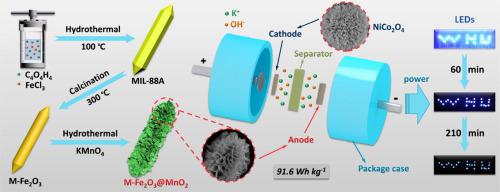Chemical Engineering Journal ( IF 13.3 ) Pub Date : 2021-03-11 , DOI: 10.1016/j.cej.2021.129243 Yucheng Chen , Chenxia Kang , Lin Ma , Likang Fu , Guanghui Li , Qiang Hu , Qiming Liu

|
The development of high-performance anode materials to match the fast-burgeoning cathodes is essential for the fabrication of high-energy-density supercapacitors. Hematite Fe2O3, with ultra-high theoretical capacitance, has been considered as a promising anode candidate, but the insufficient utilization of the energy storage potential range (mainly in -1.1V ∼ -0.5V) creates obstacles for further expansion of its electrochemical performance. In this work, a pinecone-like core-shell composite, with vertically grown MnO2 nanosheet arrays decorated on the M-Fe2O3 prepared via sacrificing the Fe-MOF (MIL-88A) template, was synthesized to achieve the excellent energy storage effect at a wide potential range from -1.1V to 0.3V. As adjusting the MnO2 coating amount to a suitable level, the M-Fe2O3@MnO2 composite exhibits a prominent specific capacitance up to 908.5 F g-1 as well as excellent cycle stability. Pseudocapacitance analysis interprets the essence of the kinetics process of composite materials in the energy storage process. The hybrid supercapacitor (HSC), assembled with pinecone-like M-Fe2O3@MnO2 as the anode and urchin-like NiCo2O4 as the cathode, delivers a high energy density of 86.8 Wh kg-1 at 804.1 W kg-1. Unsurprisingly, 25 parallel blue LEDs powered by two HSC devices can illuminate for over an astonishing 210 minutes. This work fabricates a promising anode material for high-energy-density hybrid supercapacitors, and the strategy of complementary energy storage potential provides a novel approach for constructing high-performance energy storage systems.
中文翻译:

由MFO驱动的Fe 2 O 3,其装饰有MnO 2纳米片阵列作为高能密度混合超级电容器的高级阳极
开发与快速发展的阴极相匹配的高性能阳极材料对于制造高能量密度超级电容器至关重要。具有超高理论电容的赤铁矿Fe 2 O 3被认为是很有前途的阳极候选材料,但是储能电势范围(主要在-1.1V〜-0.5V)利用不充分,为其进一步扩展制造了障碍。电化学性能。在这项工作中,是一种类似于松果仁的核壳复合材料,在M-Fe 2 O 3上装饰了垂直生长的MnO 2纳米片阵列合成了通过牺牲Fe-MOF(MIL-88A)模板制备的材料,以在-1.1V至0.3V的宽电位范围内实现出色的储能效果。通过将MnO 2的涂布量调节至适当的水平,M-Fe 2 O 3 @MnO 2复合材料显示出高达908.5 F g -1的突出的比电容以及优异的循环稳定性。伪电容分析解释了储能过程中复合材料动力学过程的本质。混合型超级电容器(HSC),以松果状M-Fe 2 O 3 @MnO 2为阳极和野孩子状NiCo 2 O 4组装而成作为阴极,在804.1 W kg -1时可提供86.8 Wh kg -1的高能量密度。毫不奇怪,由两个HSC设备供电的25个并行蓝色LED可以点亮210分钟以上。这项工作为高能量密度混合超级电容器制造了一种有前途的阳极材料,互补储能潜力的策略为构建高性能储能系统提供了一种新颖的方法。

































 京公网安备 11010802027423号
京公网安备 11010802027423号